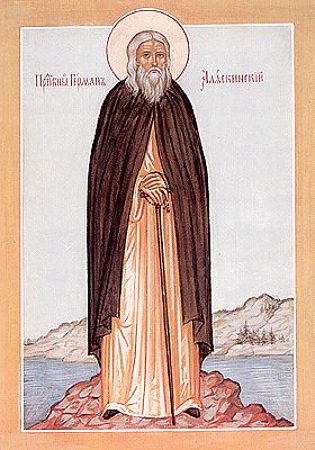
Herman of Alaska was a Russian Orthodox monk and missionary to Alaska, which was then part of Russian America. His gentle approach and ascetic life earned him the love and respect of both the native Alaskans and the Russian colonists. He is considered by many Orthodox Christians to be the patron saint of North America.
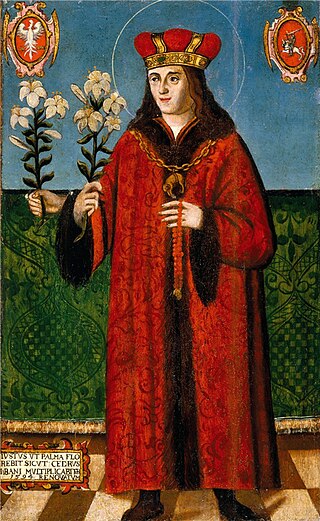
Casimir Jagiellon was a prince of the Kingdom of Poland and of the Grand Duchy of Lithuania. The second son of King Casimir IV Jagiellon, he was tutored by Johannes Longinus, a Polish chronicler and diplomat. After his elder brother Vladislaus was elected as King of Bohemia in 1471, Casimir became the heir apparent. At the age of 13, Casimir participated in the failed military campaign to install him as King of Hungary. He became known for his piety, devotion to God, and generosity towards the sick and poor. He became ill and died at the age of 25. He was buried in Vilnius Cathedral. His canonization was initiated by his brother King Sigismund I the Old in 1514 and the tradition holds that he was canonized in 1521.
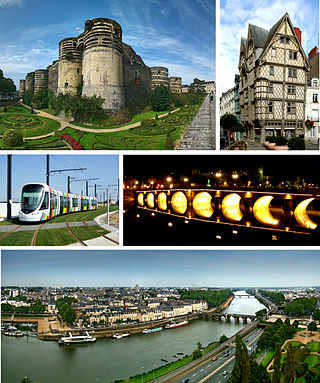
Angers is a city in western France, about 300 km (190 mi) southwest of Paris. It is the prefecture of the Maine-et-Loire department and was the capital of the province of Anjou until the French Revolution. The inhabitants of both the city and the province are called Angevins or, more rarely, Angeriens.

Father Damien or Saint Damien of Molokai, SS.CC. or Saint Damien De Veuster, born Jozef De Veuster, was a Roman Catholic priest from Belgium and member of the Congregation of the Sacred Hearts of Jesus and Mary, a missionary religious institute. He was recognized for his ministry, which he led from 1873 until his death in 1889, in the Kingdom of Hawaiʻi to people with leprosy, who lived in government-mandated medical quarantine in a settlement on the Kalaupapa Peninsula of Molokaʻi.

Anthony of Padua, OFM or Anthony of Lisbon was a Portuguese Catholic priest and friar of the Franciscan Order.

Olaf II Haraldsson, later known as Saint Olaf and Olaf the Holy, was King of Norway from 1015 to 1028. Son of Harald Grenske, a petty king in Vestfold, Norway, he was posthumously given the title Rex Perpetuus Norvegiae and canonised at Nidaros (Trondheim) by Bishop Grimketel, one year after his death in the Battle of Stiklestad on 29 July 1030. His remains were enshrined in Nidaros Cathedral, built over his burial site. His sainthood encouraged the widespread adoption of Christianity by Scandinavia's Vikings/Norsemen.

Nicholas of Tolentino, , known as the Patron of Holy Souls, was an Italian saint and mystic. He is particularly invoked as an advocate for the souls in Purgatory, especially during Lent and the month of November. In many Augustinian churches, there are weekly devotions to St. Nicholas on behalf of the suffering souls. November 2, All Souls' Day, holds special significance for the devotees of St. Nicholas of Tolentino.
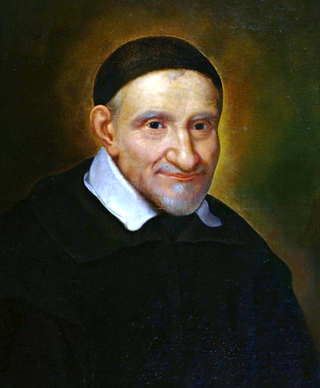
Vincent de Paul, CM, commonly known as Saint Vincent de Paul, was an Occitan French Catholic priest who dedicated himself to serving the poor.
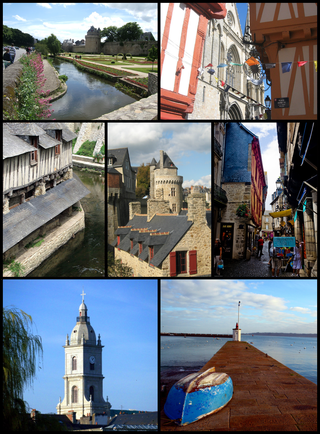
Vannes is a commune in the Morbihan department in Brittany in north-western France. It was founded over 2,000 years ago.
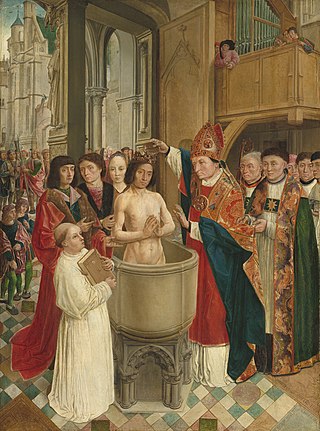
Remigius was the Bishop of Reims and "Apostle of the Franks". On 25 December 496, he baptised Clovis I, King of the Franks. The baptism, leading to about 3000 additional converts, was an important event in the Christianization of the Franks. Because of Clovis's efforts, a large number of churches were established in the formerly pagan lands of the Frankish empire, establishing a distinctly Orthodox variety of Christianity for the first time in Germanic lands, most of whom had been converted to Arian Christianity.

Cholet is a commune of western France, in the Maine-et-Loire department. With 54,307 inhabitants (2019), it is the second most populous commune of Maine-et-Loire, after the prefecture, Angers.

Saint Renatus is the name of a French and an Italian saint of the Catholic Church who is claimed to be the same person. There are different stories of two saints with by the name Renatus, who were later merged into a single one based on their described similarities and contemporaneity. Both are venerated in Italy and France. They were: Saint Renatus of Sorrento, and Saint Renatus of Angers. Part of their stories seem to be a legend, part incomplete and part deficient historically documented.
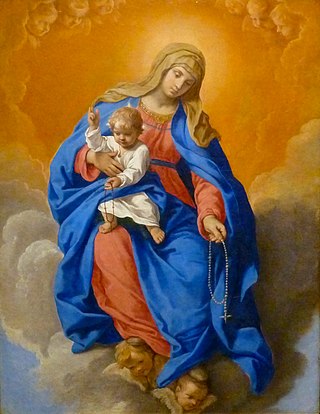
Our Lady of the Rosary, also known as Our Lady of the Holy Rosary, is a Marian title.
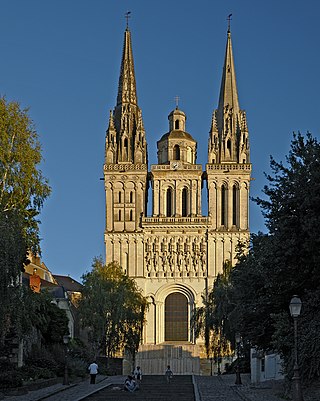
Angers Cathedral is a Catholic church dedicated to Saint Maurice in Angers, France. It is the seat of the Bishops of Angers.
The Battle of Blain, also called the Battle of Messac, was fought on 24 May 843 by the forces of Lambert II of Nantes and Erispoe, prince of Brittany, against Renaud, Frankish Count of Nantes. It arose from Breton resistance to Frankish power within Brittany and disputes over control of the County of Nantes. The defeat of the Franks led to a period of Breton expansionism.

Michel Poncet de la Rivière was a French clergyman, preacher and, from 1706 to 1730, the 79th bishop of Angers. He was the son of Vincent-Matthias Ponchet de la Riviere, the Lord Lieutenant of Alsace, and his wife, Marie Betauld; the nephew of Michel Poncet de la Rivière, the 61st Bishop of Uzès (1677–1728); the uncle of Mathias Poncet de la Rivière, the 90th Bishop of Troyes (1742–1758); and the cousin of Joseph Poncet de la Rivière, the Jesuit missionary of Canada.

Donatian and Rogatian were two brothers, martyred in Nantes during the reign of Roman Emperor Maximian, around 288–290, for refusing to deny their faith. They are also known as les enfants nantais. Their feast day is 24 May.
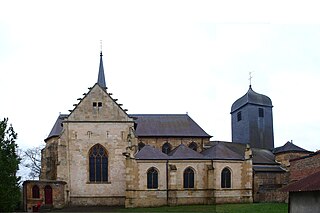
Saint Maurilius (French: Maurille) (c. 336 – 453), a priest originally from Milan, was the bishop of Angers between 423 and 453. He played an early role in the Christianization of Gaul.
Émilien of Nantes was a French religious leader who was canonized by the church as a martyr for dying in a fight against the Saracens in Burgundy in 725 AD. No written records earlier than the 16th century survive, and there are no records of a Bishop Émilien of Nantes. The legend probably has its roots in a real clash with the Saracens, who were present in the region at the time, but has been considerably embroidered.
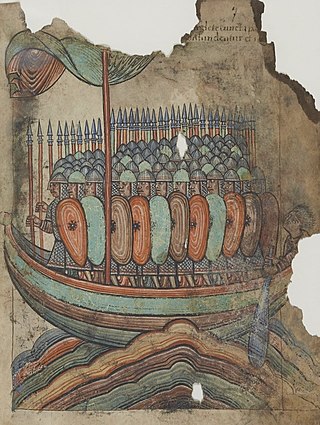
Vikings were active in Brittany during the Middle Ages, even occupying a portion of it for a time. Throughout the 9th century, the Bretons faced threats from various flanks: they resisted full incorporation into the Frankish Carolingian Empire yet they also had to repel an emerging threat of the new duchy of Normandy on their eastern border by these Scandinavian colonists.





















